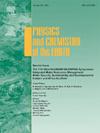Early Eocene paleoclimate and brine composition from fluid inclusion analysis of Bahadur Khel Salt, Upper Indus Basin, Pakistan
IF 3
3区 地球科学
Q2 GEOSCIENCES, MULTIDISCIPLINARY
引用次数: 0
Abstract
Fluid inclusions are crucial for reconstructing past climatic conditions because they provide information on evaporation rates and salinity variations over time. Fluid inclusion analysis of the Eocene Bahadur Khel Salt was carried out using thin sections, Raman spectroscopy, XRD, XRF, and microthermometry. Thin-section analysis indicated that the Bahadur Khel Salt predominantly comprises halite, with minor amounts of gypsum, anhydrite, and dolomite. Geochemical data indicate that halite primarily contains Na, Cl, O, Ca, Mg, Si, Al, Fe, Br, Sr, K, Zn, P, Ni, Pt, and S. Halite is not entirely pure, with an average content of 94.2 % in the primary crystals and 92.8 % in the secondary crystals. The presence of minor constituents such as calcite, ferrodolomite, ankerite, and anhydrite, as well as elements such as Mg, Ca, O, K, Si, and Al, suggests that the halite was formed from a combination of solutions with different compositions and was influenced by exposure to the atmosphere and meteoric water. Most primary crystals had a higher density than secondary crystals, indicating the presence of highly concentrated fluids. In the Bahadur Khel Salt, most inclusions are secondary and formed after deposition due to exposure to the atmosphere, which is influenced by tectonic activity and diagenetic processes. The homogenization temperature (Th) ranges from 5.8 °C to 24.3 °C, indicating varied seasonal transitions and hydrological processes, reflecting fluid entrapment under different paleoclimatic conditions. Lower Th values (5.8 °C) suggest cooler environments typical of winter or spring, indicating less evaporation and higher precipitation levels. In contrast, higher Th values (24.3 °C) reflect warmer summer conditions associated with increased evaporation and potentially drier periods.
求助全文
约1分钟内获得全文
求助全文
来源期刊

Physics and Chemistry of the Earth
地学-地球科学综合
CiteScore
5.40
自引率
2.70%
发文量
176
审稿时长
31.6 weeks
期刊介绍:
Physics and Chemistry of the Earth is an international interdisciplinary journal for the rapid publication of collections of refereed communications in separate thematic issues, either stemming from scientific meetings, or, especially compiled for the occasion. There is no restriction on the length of articles published in the journal. Physics and Chemistry of the Earth incorporates the separate Parts A, B and C which existed until the end of 2001.
Please note: the Editors are unable to consider submissions that are not invited or linked to a thematic issue. Please do not submit unsolicited papers.
The journal covers the following subject areas:
-Solid Earth and Geodesy:
(geology, geochemistry, tectonophysics, seismology, volcanology, palaeomagnetism and rock magnetism, electromagnetism and potential fields, marine and environmental geosciences as well as geodesy).
-Hydrology, Oceans and Atmosphere:
(hydrology and water resources research, engineering and management, oceanography and oceanic chemistry, shelf, sea, lake and river sciences, meteorology and atmospheric sciences incl. chemistry as well as climatology and glaciology).
-Solar-Terrestrial and Planetary Science:
(solar, heliospheric and solar-planetary sciences, geology, geophysics and atmospheric sciences of planets, satellites and small bodies as well as cosmochemistry and exobiology).
 求助内容:
求助内容: 应助结果提醒方式:
应助结果提醒方式:


